Emotional support cats belong to a broader category of animals known as Emotional Support Animals (ESAs) and are domestic cats that are specifically used to help people suffering from various mental health or emotional conditions. Unlike service animals, ESAs are not trained to perform specific tasks but to provide emotional comfort and support through their companionship.
Emotional Support Animals are animals that mental health professionals prescribe to people with emotional and psychological disorders as part of their treatment therapy. ESAs are trained to provide companionship, comfort, and emotional support to their owners, helping to relieve the symptoms of depression, anxiety, stress, and other mental health conditions. Dogs, cats, rabbits, birds, and other domesticated animals can all be trained as ESAs.
Cats can make excellent Emotional Support Animals! Felines are renowned for bonding with their owners, and their affectionate behavior can reduce feelings of loneliness and isolation. In addition, cats are relatively undemanding pets, are small enough to live in an apartment, and can be trained to perform simple tricks.
Does your cat have what it takes to become an Emotional Support Cat? Keep reading to learn more about the training and work of these unsung feline heroes!
What Are The Benefits Of Having A Cat As An ESA?
The benefits of having a cat as an ESA include emotional and physical health benefits and social and psychological benefits. In addition, a cat isn’t as demanding to care for as a dog since felines don’t need walking every day, can live indoors, eat less, and don’t take up as much space as dogs, making an ESC perfect for life in a small apartment without outside space.
Here’s what makes cats so great as Emotional Support Animals in more detail.
Emotional Benefits
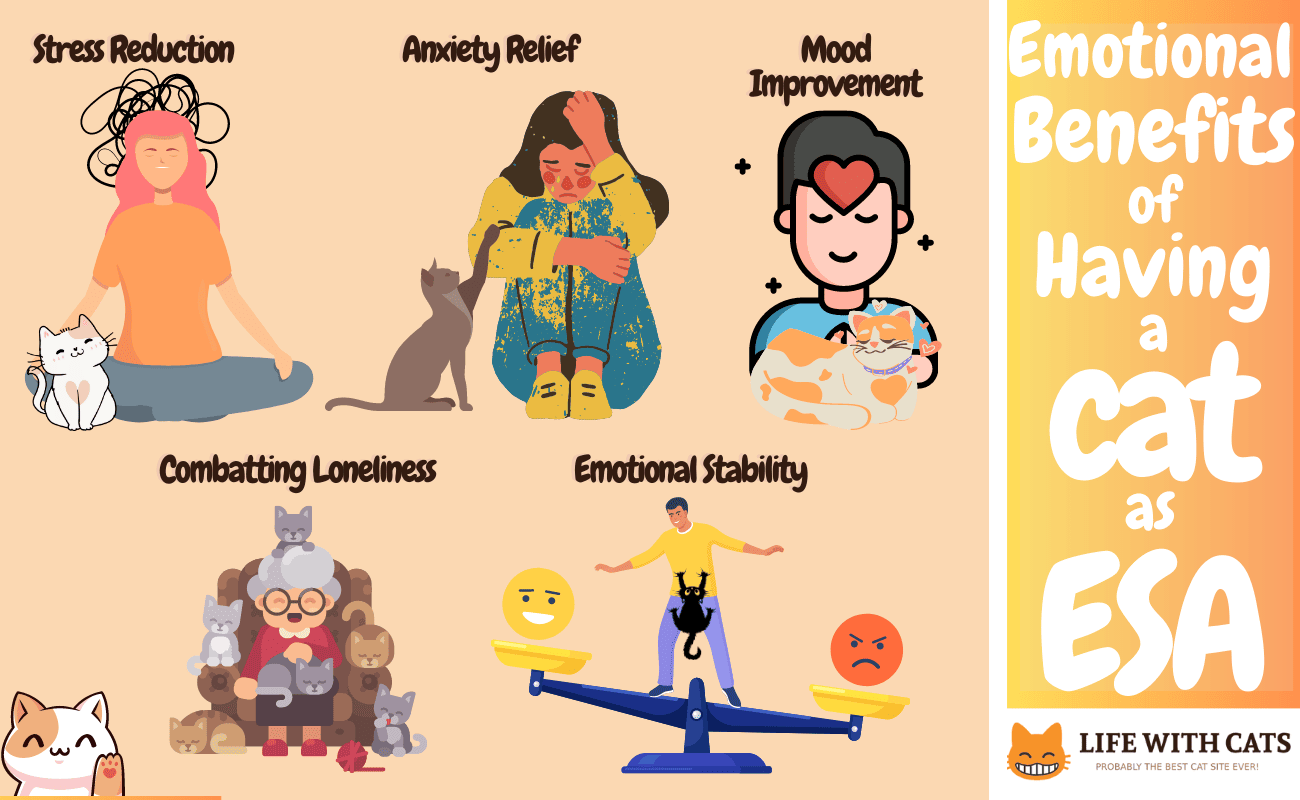
An Emotional Support Cat provides her owner with many emotional benefits, such as those detailed below.
Stress Reduction
Spending time with cats, such as petting, cuddling, and playing with them, has been shown to reduce stress hormones, such as cortisol, and increase the release of oxytocin, the “feel good” hormone. That helps people cope better with stressful situations and helps to keep them calm.
I can confirm that if I feel stressed out, I first reach out to stroke one of my pets, usually a cat. There’s something soothing about the feeling of my pet’s soft, silky fur and her gentle purring that immediately relaxes me and eases the stress of the day.
Anxiety Relief
When you interact with your cat, your body produces neurotransmitters, including serotonin and dopamine, commonly associated with pleasure and relaxation. A purring pussycat rubbing her head against you affectionately in sheer pleasure can also bring comfort and security, reducing anxiety and promoting a sense of well-being.
Mood Improvement
Domestic pets, especially dogs and cats, are well known for their ability to provide unconditional love and companionship, and interacting with our furry friends is often linked to increased levels of serotonin and endorphins, which can improve your mood and help combat feelings of sadness and depression.
Combatting Loneliness
When someone lives alone, it’s easy for them to experience feelings of isolation and loneliness, and having a cat can significantly reduce that. Cats provide companionship, and having them around can give you a sense of purpose and responsibility, fostering a deeper connection with others.
For example, one of my neighbors is elderly and recently lost her husband. Cath lives alone, but fortunately, she has a cat, Tilly, who is her constant companion and provides her with something in common with many of her neighbors, who have consequently become her friends through chatting about their pets over the garden fence.
Emotional Stability
Having a cat around constantly helps to provide emotional stability and gives you a sense of routine. Your furry friend’s unconditional and non-judgmental love can offer comfort when times are tough, helping you feel emotionally supported and grounded.
Physical Health Benefits
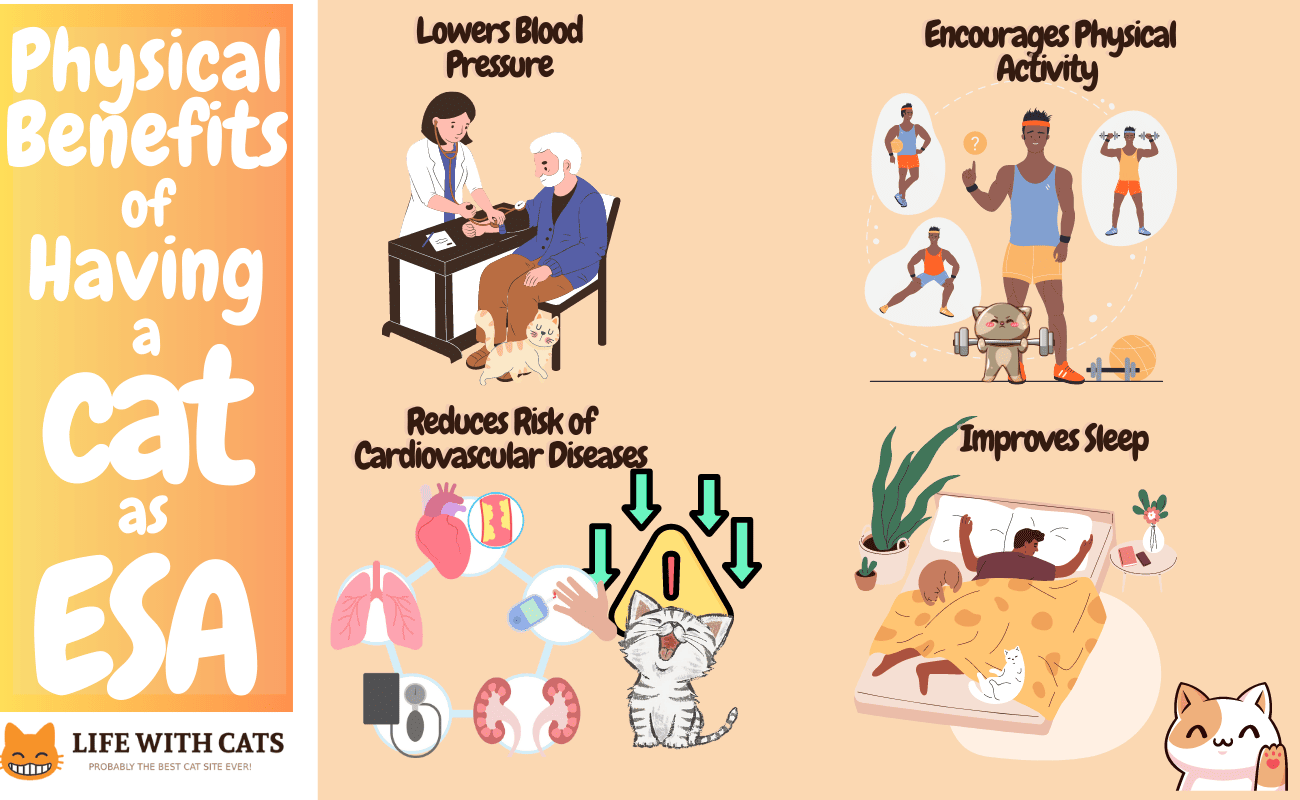
In addition to the emotional support benefits owning a cat can provide, she brings physical health benefits too, and can even reduce the risk of cardiovascular disease.
Lowers Blood Pressure
Scientific studies show that spending time around pets, including cats, can lead to reduced blood pressure, especially in stressful situations. Basically, the calming effect of interacting with your cat can contribute to improved overall cardiovascular health and help reduce the risk of hypertension or high blood pressure.
Encourages Physical Activity
Although owning a cat doesn’t demand as much physical activity as walking a dog, your pet will still need exercise to keep her fit and healthy. That involves playing games and training your cat daily, which helps you maintain a healthier lifestyle and motivates you to engage in more physical exercise.
Reduces Risk Of Cardiovascular Diseases
The combination of stress reduction and increased physical activity associated with owning a cat can contribute to a reduced risk of cardiovascular diseases, including heart attacks and strokes.
Improves Sleep
Owning a cat has been shown to improve your sleep quality since your pet’s presence in the bedroom brings a sense of security, reduces feelings of loneliness, and helps you relax, all promoting better sleep patterns.
Of course, if you have a cat that prefers to go outside at night, that doesn’t apply, especially if she wakes you, demanding to be let out!
Social Benefits
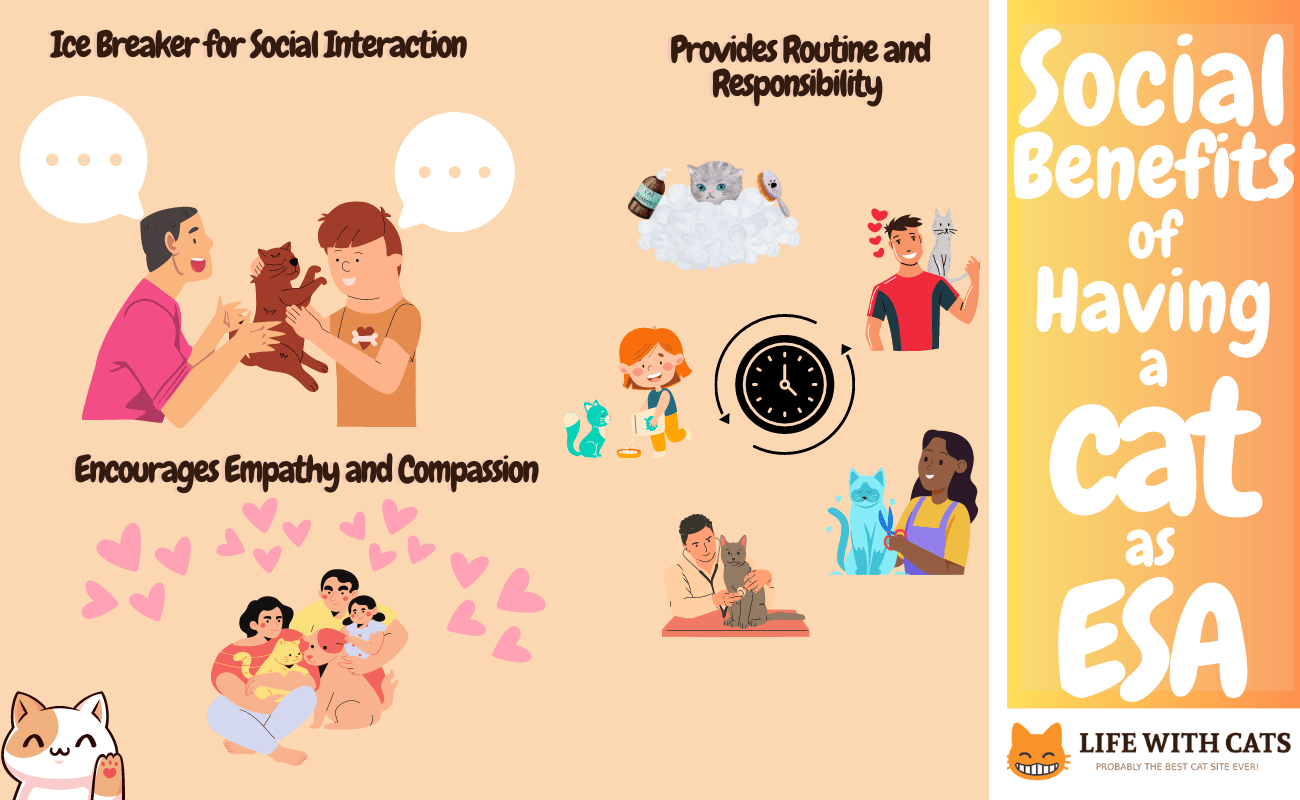
Often, a pet is often their sole companion when someone lives alone, either through choice or due to a bereavement. But caring for that pet demands some kind of interaction with other people, whether that’s through trips to the vet, walks in the park, or chatting with pet-owning neighbors over the garden fence. So, owning an ESA can have valuable social benefits, as we explain below.
Icebreaker For Social Interaction
Cats can act as social catalysts, helping you to initiate conversations with other pet owners. As mentioned above, you might chat with another cat-owning neighbor across the garden fence or chat with a local cat-owning Facebook group, which can foster a sense of community.
Provides Routine and Responsibility
Caring for a cat means establishing a regular routine for feeding, grooming, training, and exercise, creating a sense of responsibility and accountability, which are essential social skills in everyday life.
Encourages Empathy and Compassion
By tuning in to your cat’s feelings of needing and wanting love, attention, food, respect, and companionship, you will learn how to care for another living creature, helping you tune into other people’s feelings more intuitively.
For example, when a child learns how to hold a pet and knows when the animal wants to be put down and set free, they learn how to consider another creature’s needs.
Psychological Benefits
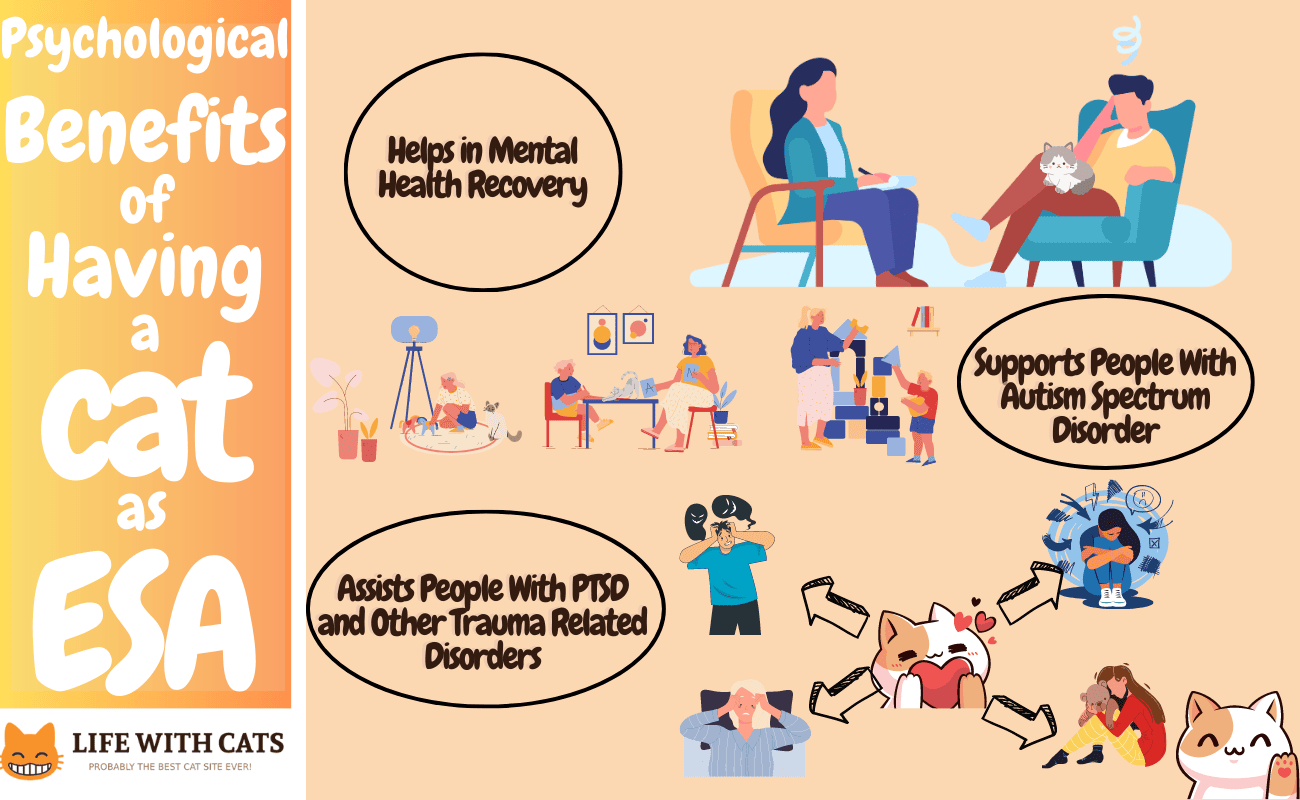
Cats can provide invaluable psychological benefits for their owners, especially in those recovering from mental health challenges.
Helps In Mental Health Recovery
People dealing with mental health issues, such as anxiety and depression, can benefit hugely from the presence of cats and their emotional support. Cats can offer a non-judgmental and consistent comfort source, which is instrumental in helping those with mental health conditions recover.
Helps People With Autism Spectrum Disorder
A cat’s non-verbal communication helps create a calming, safe environment for people on the autism spectrum, which can reduce anxiety and improve social skills.
Assists People With PTSD and Other Trauma-Related Disorders
Pets, including cats, are valuable companions for people with post-traumatic stress disorder (PTSD) and other trauma-related disorders since having an Emotional Support Cat around their home can help reduce symptoms of depression and anxiety and improve the person’s overall emotional well-being.
How To Choose The Right Cat For ESA Training
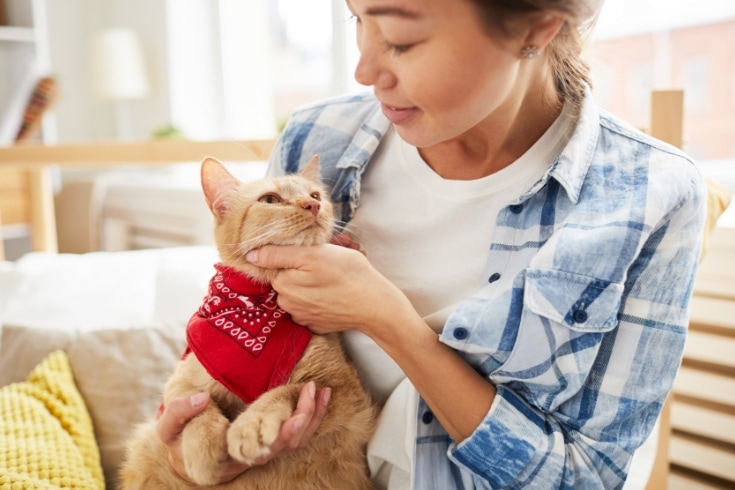
Choosing the right cat for ESA training involves taking a number of important factors into account. So, does your feline friend have what it takes?
Basically, the cat must be physically healthy, have a calm, friendly temperament, and be adaptable to different situations and environments.
Now, let’s explore the considerations for choosing the right cat for ESA training.
Consideration Of Cat’s Age
The first thing to consider is the age of the cat. You can train kittens and adult cats to provide emotional support to their owners, but both have pros and cons.
Kittens
There are advantages and disadvantages of training kittens as Emotional Support Animals:
PROS
- Kittens are more receptive to socialization and training, which makes it easier to shape and condition their behavior.
- Raising a kitten from an early age strengthens the bond between you and your cat.
- Training a kitten enables you to shape their behavior according to your needs from the beginning, helping create a long-term partnership.
CONS
- Kittens are full of energy and might require more playtime and exercise than older cats, which can lead to a lack of focus during training sessions.
- Just like children growing up, a kitten’s personality changes as it matures, and that makes it more difficult to predict their suitability as an ESA.
Adult Cats
So, is it easier to train an adult cat to be an ESA than to train a kitten?
PROS
- An adult cat has an already established personality, so you can tell if she has the right temperament to become an ESA.
- Adult cats are typically calmer than kittens and can be more focused on their training.
- An adult cat is ready to provide support and companionship immediately.
CONS
- An adult cat might have experienced trauma or behavioral issues that need more effort to address and modify.
- Establishing a strong bond with an adult cat might take longer than it would if raising a kitten.
- An adult cat, especially one with an uncertain past, might have developed undesirable habits and behaviors that must be addressed during training.
Understanding Cat Breeds
Different cat breeds can have different personalities, energy levels, trainability, and temperaments, making some more suitable for life as an ESA than others. Here are a few of the most popular ESC breeds and the key character traits that make them so suitable for caring companion roles.
Character Traits of Different Cat Breeds
- Maine Coon: These large cats are known to be gentle, friendly, sociable, and intelligent.
- Siamese: Siamese cats love to be around people and are extremely affectionate, social, and vocal.
- Ragdoll: These beautiful fluffy cats are well-known for their affectionate, gentle nature and are the ultimate relaxed companions who love their owners.
- Persian: Persian cats tend to be laid back and calm, preferring to live in a peaceful environment on a one-to-one basis with their owner.
- Bengal: These cats are highly intelligent, playful, and energetic, making them wonderful companions for someone who enjoys training their pet. The Bengal’s main downside is that the breed needs plenty of mental and physical stimulation to be happy.
- Sphynx: Sphynx cats love Close contact with their owner, are highly social, and are known as attention-seekers.
- British Shorthair: this cat breed is friendly, adaptable, and known to be easy-going and chilled out.
Selecting A Breed That Matches Your Lifestyle and Needs

When choosing a cat breed that best matches your lifestyle and needs, consider your living situation and the amount of time you can dedicate to training and interacting with your ESC. If you prefer a calm, low-energy cat, a Persian or British Shorthair breed could be a good fit for you. However, if you’re pretty active and prefer an interactive ESC that demands more attention, Siamese or Bengal cats would be perfect for you.
Another important consideration is whether you or your family members have allergies. The first thing to understand is that pet allergies are caused by the dander produced by the animal rather than its fur. Dander is comprised of dead skin cells and saliva, which the cat leaves on her fur each time she grooms herself. When the cat moves around your home and lies on your bed, chairs, and carpets, she sheds dander, which floats up into the air as people walk around, where it’s inhaled by allergy sufferers, triggering an allergic reaction.
The more time you can spend grooming your cat will reduce shedding, which in turn helps to reduce the amount of dander that falls onto your carpets and home furnishings, and the less dander your cat sheds, the less severe the allergic reaction it will trigger. For that reason, it’s best to choose a short-haired breed and set aside time each day for grooming your pet.
Evaluating Cat’s Temperament
It’s essential to choose a cat with the right temperament to be an ESA. For example, nervous or aggressive cats are unsuitable for the role. Instead, you want a relaxed, friendly, affectionate, and calm cat.
Recognizing The Signs Of A Calm And Friendly Cat
When evaluating a cat’s temperament for potential ESA training, you should look out for the signs of a calm and friendly cat, including the following:
- A friendly cat will come to you willingly with no signs of aggression or fear.
- The cat should show an interest in spending her time around humans and not appear shy or try to hide away when approached.
- The cat’s body language should appear relaxed, calm, and comfortable, with no signs of tension.
Importance Of Adaptability In An ESA
Adaptability is an extremely important quality in an ESA because these pets will often be exposed to new, unfamiliar surroundings, including public spaces and public transport in some cases. So, a cat that stays calm and composed in different situations will be much better suited to provide emotional comfort and support for her owner during times of stress or anxiety.
Cat’s Health Check
Your cat won’t make a good ESA unless she is in excellent health and physical condition since the training required for this role can be quite strenuous, and you need to know that your cat is physically up to the challenge.
Importance Of A Thorough Vet Check
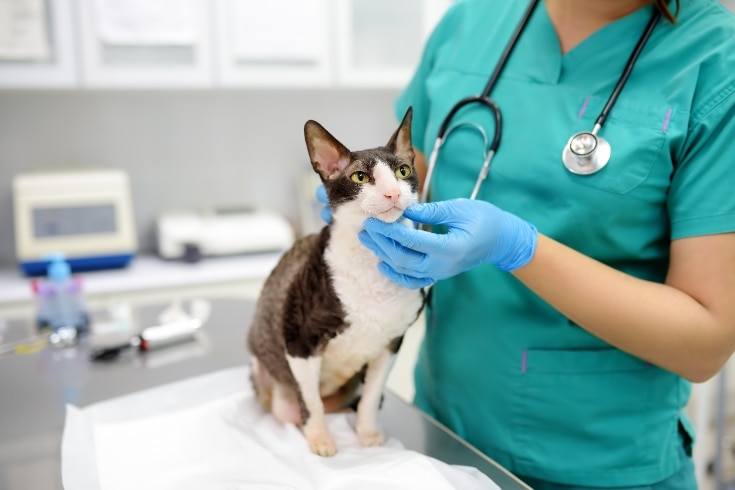
Before finalizing your decision on whether your cat is suitable for a role as an ESA, you’ll need to have her undergo a comprehensive health examination by a veterinarian. A vet check can ensure that the cat is in good health and free from any contagious diseases or underlying medical conditions that might affect her ability to be an ESA.
Vaccination And Spaying/Neutering
You should ensure your cat is up to date with her vaccinations to keep her protected from preventable diseases.
Having your cat spayed or neutered is essential for various reasons, including the prevention of unwanted litters of kittens and to help modify unwanted behaviors such as aggression and territorial tendencies.
Step-By-Step Guide To ESA Cat Training
In this step-by-step guide to ESA cat training, you can learn how to teach your cat to be an efficient, effective Emotional Support Animal.
Your cat will learn to be obedient to basic commands and socialization and learn specific emotional support commands and more advanced ESA training.
Teach Basic Obedience Commands
The first thing to do is teach your cat a few basic obedience commands, such as “sit,” “stay,” and “come.”
- Sit: To train your cat to sit, hold a treat close to your cat’s nose and slowly move it upward, causing the cat to sit down naturally. At the same time, use the verbal cue “sit” and immediately reward your cat with a treat and verbal praise.
Repeat that several times until your cat associates the command with the action, and gradually phase out giving her a treat every time you ask her to sit down.
- Stay: With your cat in her sitting position, hold your hand up in front of your pet’s face like a stop sign and say “Stay” in a firm voice. Take a step back away from your cat, and if she remains in place, reward her with a treat and verbal praise.
- Come: To teach your cat to come to you when you call her, squat down, and say “Come” while encouraging your pet with a treat or her favorite toy. When the cat approaches you, reward her immediately with treats and petting.
Leash And Harness Training
Training your cat to walk with you on a harness and leash means she can accompany you to potentially stressful environments where you need reassurance and emotional support, such as doctor’s appointments. In addition, if you live alone, you might enjoy taking your cat to a cat-friendly cafe where you can chat with other feline fans and make a few new friends.
Step 1 – Introduce The Harness
Start by introducing your cat to her harness by placing it close to her bed or food and allowing her to investigate the harness by sniffing it.
Step 2 – Putting On The Harness
Once your cat is comfortable with the harness, gently place it on her back and secure it. Reward your pet with treats and positive reinforcement while she wears the harness, gradually increasing the duration.
Step 3 – Leash Introduction
Now, you can attach a lightweight leash to the cat harness and allow your pet to drag it around while you supervise her. That helps to get your cat accustomed to the feeling of being tethered.
Step 4 – Leash Walking
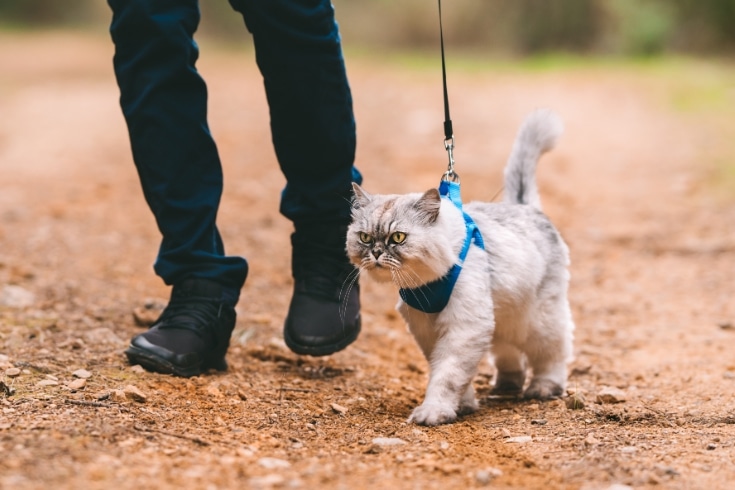
Hold the leash loosely and start walking with your cat inside your house. As you walk around, encourage your cat with praise and treats to make the whole experience enjoyable for her. You must be extremely patient during this stage of your cat’s training, as some felines take longer to adjust to walking on a leash than others.
Teach Basic Socialization Training
As an ESC, your cat will be expected to be well-socialized in many different environments, with strangers and different animals, so you should pay close attention to this aspect of her training.
Introducing New People and Environments
Step 1 – Gradual Exposure
Start by gradually introducing your cat to new people and environments, beginning with one person at a time in familiar surroundings, then gradually increasing the number of people and exposure to new places.
Step 2 – Positive Reinforcement
Reward your cat with plenty of affection and treats when they remain calm and relaxed around new people and in new places. Never force interactions or overwhelm your cat, as that will cause anxiety and set back your training process.
Interaction With Other Animals
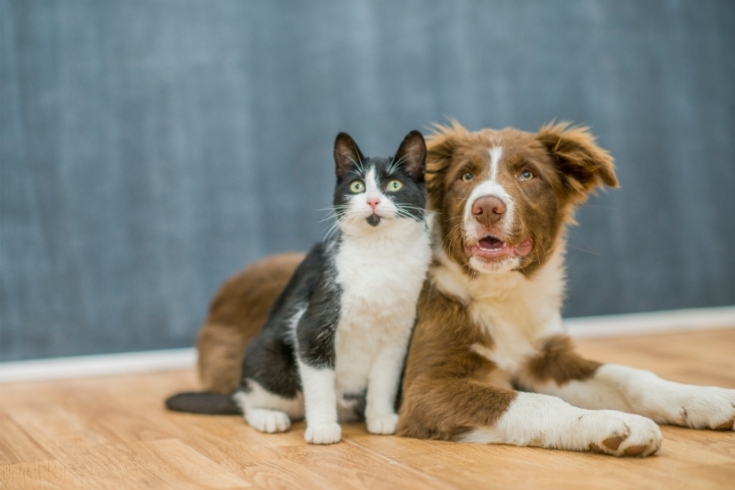
Step 1 – Supervised Meetings
The last thing you want is for your cat to be chased down the garden by a feisty dog or attacked and frightened by another cat. So, when you begin introducing your cat to other animals, you must always keep the interactions supervised closely to ensure the safety of both parties and prevent aggressive behavior.
Step 2 – Positive Associations
When introducing your cat to strange animals, be sure to use plenty of treats and rewards to create positive associations with those other animals. Reward your cat when she exhibits friendly and non-threatening behavior towards other furry friends.
Teaching Emotional Support Commands
As an ESA, your cat must be highly responsive to various emotional support commands. She needs to be emotionally attuned and capable of exhibiting comforting behavior towards her owner.
Teaching Emotional Responsiveness
Step 1 – Recognizing Emotions
Cats are highly sensitive to their owner’s emotional states and will naturally offer comfort when you need it, which is what makes your furry friend so well suited to working as an Emotional Support Animal.
Pay attention to your emotions and feelings and encourage your cat to be close to you when you’re feeling calm and content.
Step 2 – Positive Reinforcement
When your cat displays comforting behavior, such as purring, cuddling, or nuzzling, be quick to praise and reward her. Positive reinforcement encourages your cat to be more responsive to your emotional needs and makes her more likely to repeat that desirable behavior in the future.
Encouraging Comforting Behavior
Step 1 – Safe Spaces
Set aside an area in your home for your cat as a safe space equipped with comfortable bedding and toys. Encourage your cat to use that space when she senses your emotional distress, allowing her to be there for you when you need support.
Step 2 – Comforting Touch
You can teach your cat to offer comforting touches by gently petting her when she comes to you during times of emotional distress so that, over time, your pet will associate this action with comforting you.
Advanced ESA Training
Once you have the basics in place and your cat is confident in the essentials, you can move on to more advanced ESA training, such as training your cat to respond to emotional distress and understanding custom commands for specific needs.
You must be consistent and patient throughout your cat’s training and use positive reinforcement. Always prioritize your cat’s comfort and well-being during the training process, and if you encounter challenges, consider seeking guidance from a professional animal behaviorist or veterinarian who specializes in ESA training.
With time and effort, your ESA cats can become a reliable source of emotional support and a cherished companion in your life.
Responding To Emotional Distress
You can train your cat to recognize your specific emotional distress triggers by teaching her specific signals or commands to alert you or others when you need emotional support.
For example:
- Choose a specific signal or command that you will use to tell your cat you are experiencing emotional distress.
- Use positive reinforcement in the form of treats so that your cat associates the signal with a reward. Repeat the exercise frequently and consistently until your cat learns that when you give the signal, she will be given a reward.
- When you feel emotionally distressed, use your chosen signal while displaying the appropriate body language.
- If your cat comes over to you after you’ve given her the signal during your distressed state, be sure to reward her immediately with treats and praise to reinforce the connection between your emotional distress and the signal.
- Once your cat responds reliably when you are in distress, start using the signal in different scenarios to be sure that the cat has generalized the behavior and will respond to the signal, regardless of your emotional state or where you are.
- To get your cat to alert others when you are in emotional distress, involve those people in the training process as well, teaching them the signal you will use and the positive reinforcement response with treats.
Custom Commands For Specific Needs
If you have specific emotional support needs, you can train your cat to provide you with tailored assistance by performing custom commands, such as fetching a specific object, providing pressure therapy, or leading you to safety during panic attacks.
For example:
- Choose a specific signal or verbal cue that you will use to tell your cat you want her to lead you to safety during a panic attack.
- Use positive reinforcement so that your cat associates the cue with a reward, such as treats or a favorite toy. Repeat the process consistently until your cat learns that when you give the verbal cue, she will receive a reward.
- When you feel a panic attack coming on, use your chosen signal and encourage your cat to lead you to a safe place.
- If your cat comes to you after you’ve given her the verbal cue, reward her immediately with treats and praise to reinforce the connection between your emotional distress and the verbal cue.
- When your cat understands that you need her to come to you when you give her the verbal cue, try using it in different locations to teach your pet to lead you to safety wherever you are.
What Are The Legal Aspects Of Emotional Support Cats?
Legal aspects of emotional support cat training include understanding ESAs’ rights and how to get an Emotional Support Cat to live with you as your beloved pet.
This area can be something of a minefield, so we strongly recommend you read this part of our guide, and feel free to ask any questions you might have in the comments box at the bottom of the article.
Understanding Legal Rights For Emotional Support Animals
Unlike service animals, ESAs do not need special training to perform specific tasks but are prescribed by licensed mental health practitioners as part of a treatment plan designed to relieve the symptoms of a person’s psychological or emotional disability.
Here’s a detailed overview of the legal rights pertaining to Emotional Support Animals.
Fair Housing Act (FHA)
The Fair Housing Act is a federal law that prohibits discrimination against people with disabilities in housing. Under the FHA, landlords, property managers, and other housing providers must make reasonable accommodations for those with disabilities who have ESAs.
That means if you have an Emotional Support Cat, you cannot be denied housing or be charged an additional pet fee or pet deposit, even in buildings with “no pets” policies. However, you must request an exception to “no pets” housing policies, accompanied by an ESA letter from a licensed mental health professional confirming the person’s need for the Emotional Support Cat because of their disability.
Air Carrier Access Act (ACAA)
The Air Carrier Access Act is another federal law that allows individuals with disabilities, including those with ESAs, to travel with their animals on commercial airlines without having to pay additional fees or being subject to restrictions. Airlines must also make reasonable accommodations for Emotional Support Cats to accompany you in the cabin.
Employment
Unlike service animals, ESAs do not automatically get the same level of access to workplaces under the Americans with Disabilities Act (ADA). However, in some cases, reasonable accommodations could be made for an employee with an Emotional Service Cat, especially if the cat’s presence is necessary to provide a productive working environment for the person with a disability.
Public Places
ESAs don’t enjoy the same level of access to public places as service animals and are generally only allowed in pet-friendly places. However, state and local laws can vary, so be sure to research specific regulations in your area to determine whether your cat is welcome.
How To Get An Emotional Support Cat
Getting an Emotional Support Cat involves several steps and must be approached with care to ensure the cat is beneficial for your emotional well-being.
The process involves consulting with a licensed mental health professional and undergoing a mental health evaluation. If the mental health professional prescribes you an Emotional Support Cat, you must obtain a letter from them stating that, and then you can apply to get a suitable cat.
Consulting With A Licensed Mental Health Professional
The first step in getting an Emotional Support Cat is to consult with a licensed mental health professional, who could be a psychologist, psychiatrist, licensed clinical social worker, or any other qualified professional who can diagnose and treat mental health conditions.
Have A Mental Health Evaluation
As part of your consultation, you will undergo a mental health evaluation to assess your emotional and psychological state, determine if you have a qualifying mental health condition, and see whether an Emotional Support Cat would benefit your treatment plan.
Obtaining An ESA Letter
If your mental health professional decides that an Emotional Support Cat would benefit your condition, they will give you a formal ESA letter printed on their official letterhead, confirming your need for an ESC as an accommodation for your disability and including certain other essential elements.
Not all mental health professionals are qualified to issue ESA letters, and only licensed mental health professionals legally allowed to practice in your state should provide a valid ESA letter.
What Is Your ESA Letter Legally Required To Have?
To be considered a valid ESA letter, it must have the following:
Official Letterhead Of Your Mental Health Provider
Your ESA letter must be printed on the official letterhead of the licensed mental health professional who issued it to ensure its authenticity and credibility.
Statement About Your Disability And ESA Qualification
The ESA letter should clearly state that you have a qualifying mental or emotional disability that’s recognized by the Diagnostic and Statistical Manual of Mental Disorders (DSM) and that an Emotional Support Cat is recommended as part of your treatment plan to alleviate symptoms of your disability.
License And Contact Information For Your Clinician
The ESA letter must include your mental health professional’s license number, type of license, and contact information, including their name, address, phone number, and email.
Date Of Issuance
Your ESA letter must have an official date of issuance because some housing providers and airlines might request the letter to be no older than one year.
FAQs
In this part of our guide, we answer some more of the most commonly asked questions about training and obtaining an Emotional Support Cat.
Can I Train An Adult Cat To Be An ESA Or Does It Have To Be A Kitten?
Yes, you can train an adult cat to be an ESA. Adult cats generally focus better because they are less excitable and can be trained with patience and positive reinforcement.
Can All Cats Be Trained To Be ESAs?
Although most cats can be trained to be ESAs, individual temperament and personality play a significant role in their suitability, and not every cat has what it takes. Some cats are naturally more affectionate and, therefore, more emotionally supportive, making them excellent candidates for the role.
It’s really just a case of assessing your cat’s behavior and willingness to be trained before committing to ESA training.
How Can I Legally Certify My Cat As An ESA?

There is no official legal certification or registry for ESAs in the United States. To qualify your cat as an ESA, you will need a letter from a licensed mental health professional stating that you have a mental or emotional disability and that your cat provides you with the emotional support that helps manage symptoms of your condition.
That ESA letter is the official document required for housing and travel accommodations under the Fair Housing Act (FHA) and the Air Carrier Access Act (ACAA).
What Do I Do If My Cat Is Not Responding Well To ESA Training?
As mentioned earlier, not all cats take well to ESA training, and if your cat is not responding well, take a step back and look closely at your training methods. Positive reinforcement, patience, and consistency are critical when training cats, and it might be worth consulting a professional animal trainer or a vet with experience in ESA training for some advice and guidance on how you could modify your training approach.
How Long Does It Typically Take To Train A Cat To Be An ESA?
The time it takes to train your cat to be an ESA will vary significantly depending on the cat’s individual personality, previous training experiences, and how consistent you are in your approach. Some cats will take well to training and learn everything they need to know within a few weeks, whereas others might might several months to train.
Can My Cat’s ESA Training Be Maintained At Home, Or Should I Hire A Professional?
Although much of the basic ESA training can be done at home, hiring a professional animal trainer with experience in this field is beneficial, especially if you encounter challenges or have specific training goals in mind. A professional can give you expert guidance, create a personalized training plan, and help you deal with your cat’s behavioral issues more effectively.
What Are The Benefits Of Having My Cat Trained And Certified As An ESA?
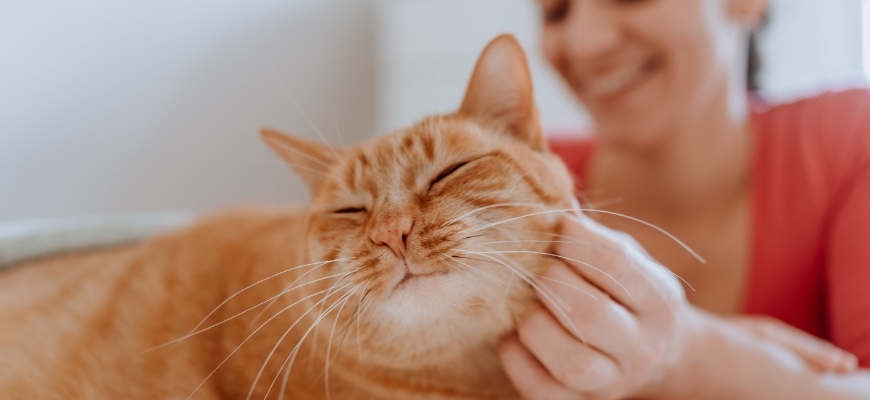
Having your cat trained and certified as an ESA provides several important benefits, including improved support for your mental or emotional condition, reduced anxiety and stress, assistance with emotional regulation, and the ability to live in housing that typically does not permit pets or travel with your cat in an aircraft cabin.
Are There Any Legal Protections Or Privileges For ESA And Their Owners?
Yes, under the Fair Housing Act (FHA) and the Air Carrier Access Act (ACAA) in the United States, you get certain legal protections if you have a certified ESA. For example, the FHA allows you to live with your ESA in accommodation that has pet restrictions, and the ACAA allows ESAs to fly with their owners in an aircraft cabin without paying an additional pet fee.
How Often Does My Cat Need To Practice Or Refresh Its ESA Training?
Although there are no official requirements for your cat to refresh her ESA training, we recommend regular practice and reinforcement of the commands she has learned to keep your pet responsive to your emotional needs.
With that in mind, it’s a good idea to have daily training sessions and interactive play times, which will also strengthen the bond between you and your cat.
What Should I Do If My ESA Cat Behaves Aggressively Or Inappropriately?
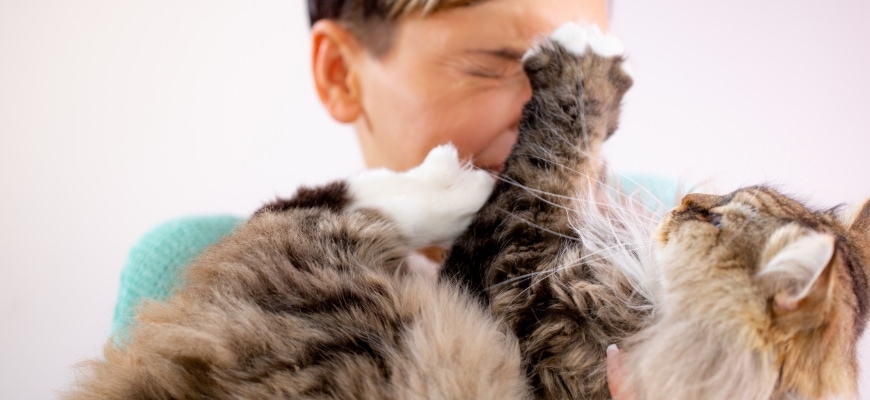
If your ESA cat behaves aggressively or inappropriately, it’s essential to address the problem right away. Start by consulting a vet to rule out any underlying health conditions that might be triggering or contributing to the behavior, and if your cat is given the all clear, discuss her behavior with a professional animal trainer to create a behavior modification plan.
Can A Cat With Health Issues Be Trained To Be An ESA?
Whether you can train a cat with health issues to be an ESA depends on the specific health conditions the cat has and their impact on her well-being and abilities to fulfill the role. I recommend consulting your vet to see if your cat’s health problems could affect her ability to be an ESA and be guided by their recommendations.
Where Can I Find More Resources About ESA Cat Training?
You can find more resources about ESA cat training from online articles, books on the subject, and reputable websites, and you could also reach out to professional animal trainers and organizations that specialize in ESA training for guidance and valuable insights. However, be sure to verify the credibility of the information sources you use to know their advice is up-to-date and accurate.
Conclusion
The benefits of having a cat as an ESA include many emotional and physical health benefits and social and psychological pluses. That includes support for people with autism, helping recovery from mental health disorders, providing a routine, reducing the risk of cardiovascular diseases, and lowering blood pressure.
To get an ESA letter from a mental health professional, you’ll need to attend a consultation, during which the doctor will evaluate you and decide whether an Emotional Support Cat would help you to manage your condition.
To find out more about training your pet cat to be an ESA, check out online articles written by reliable sources and consult with expert animal behaviorists with experience in the field.